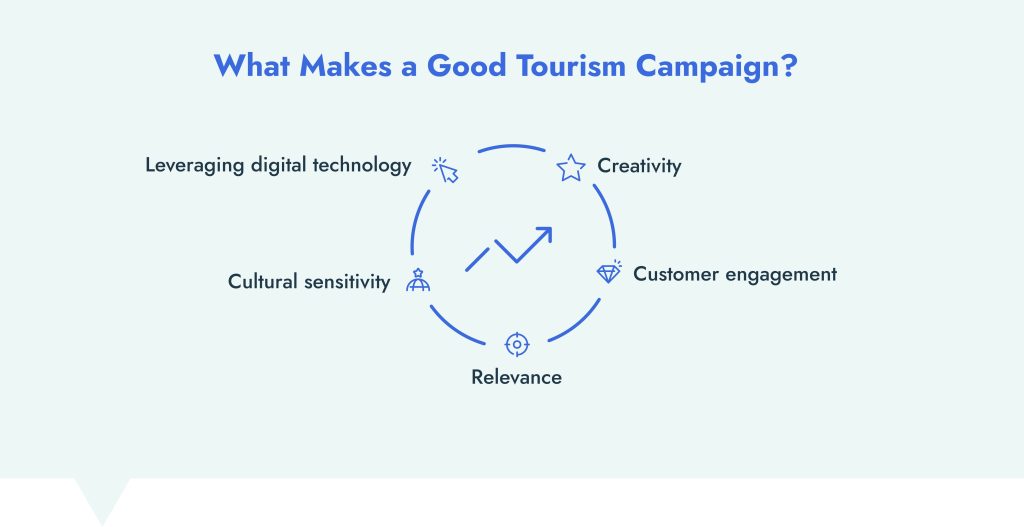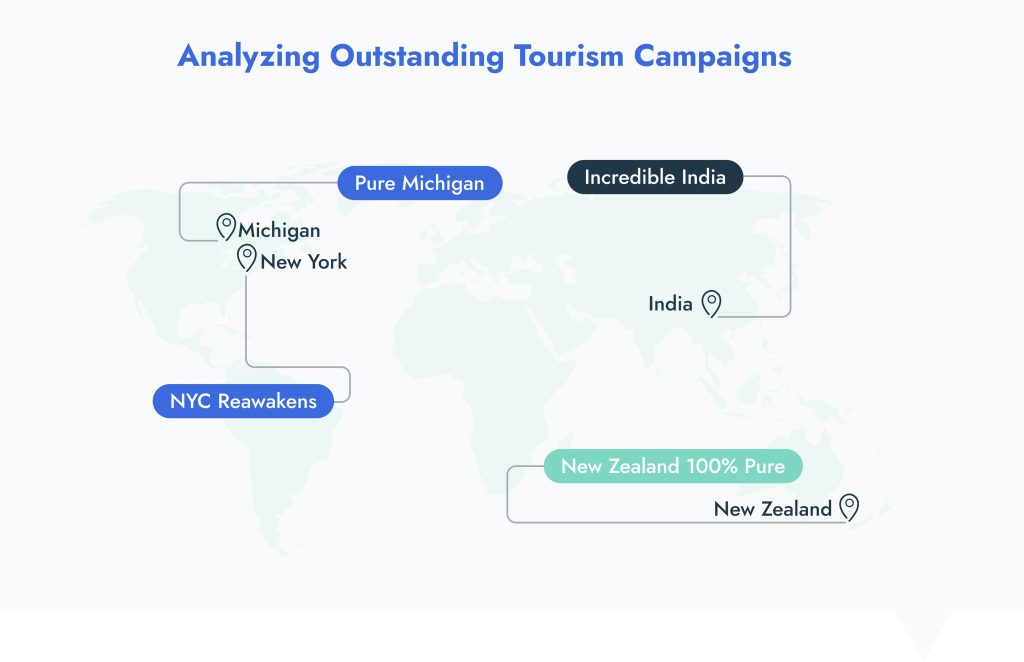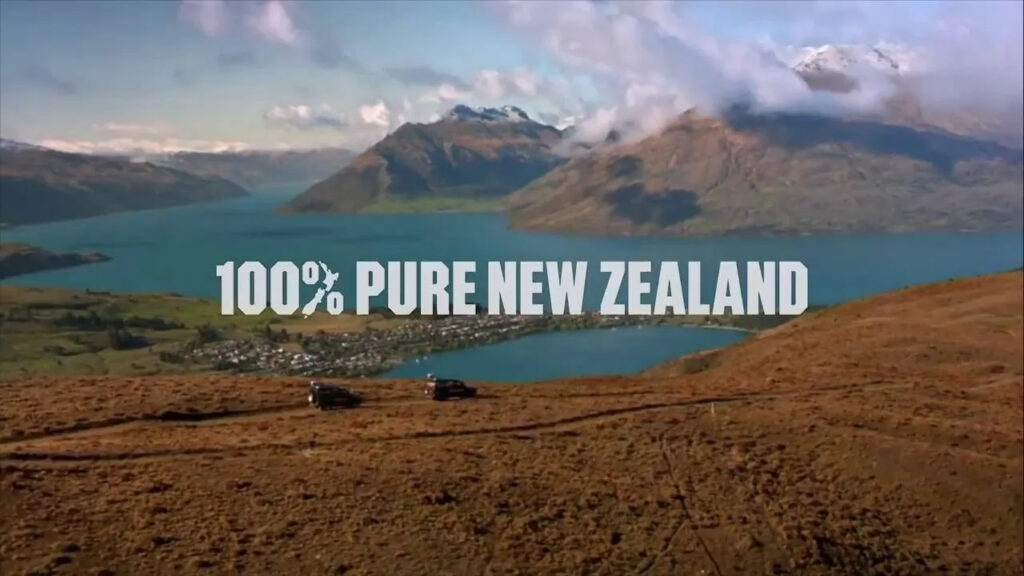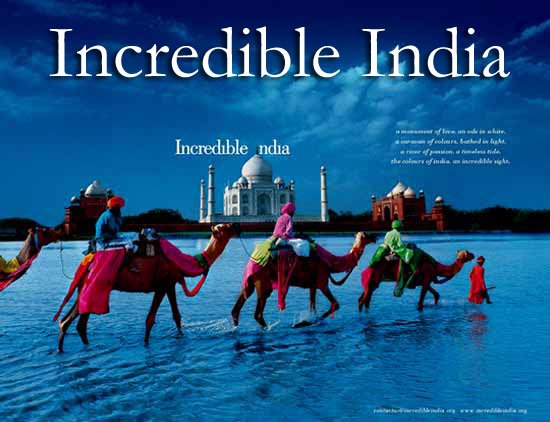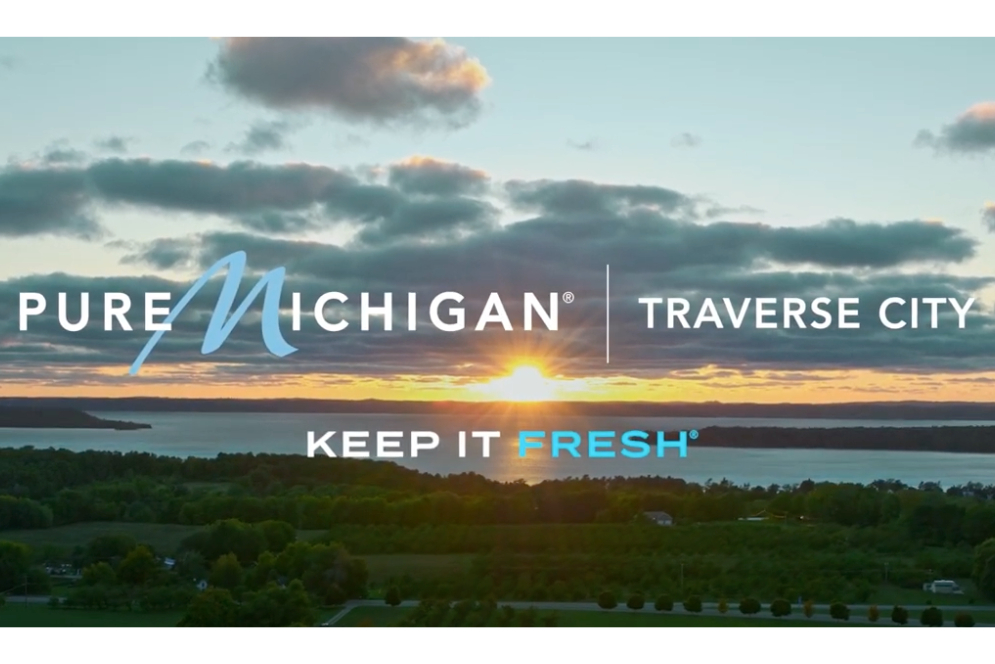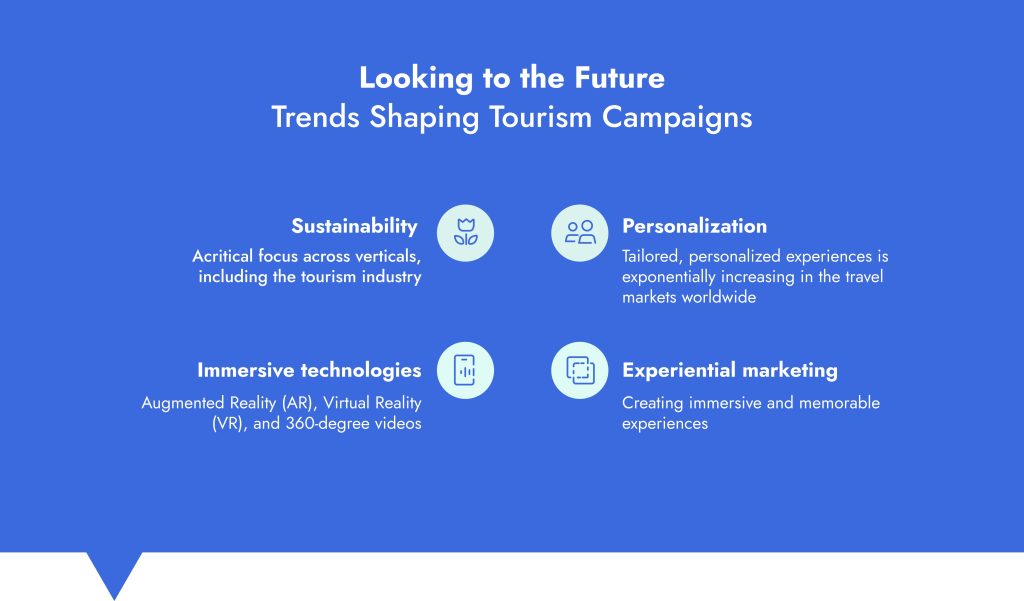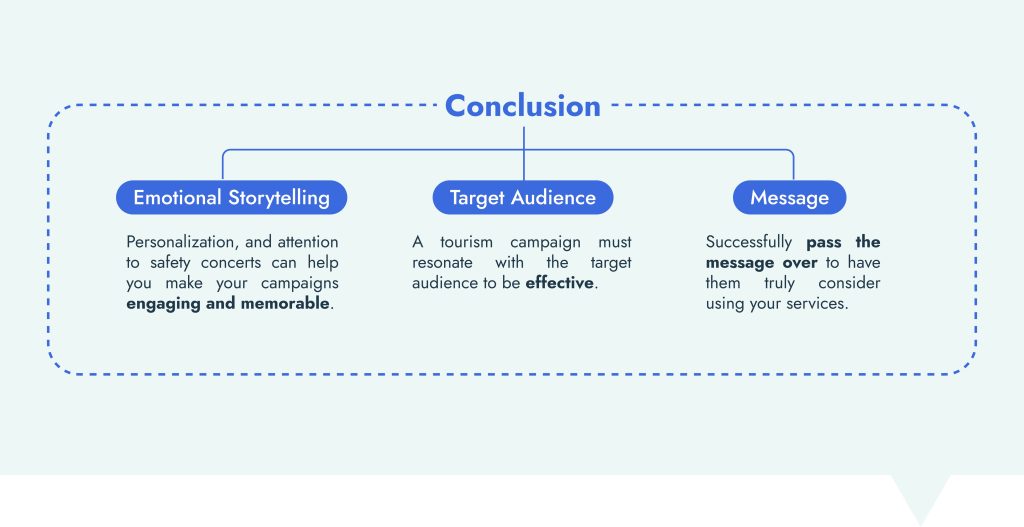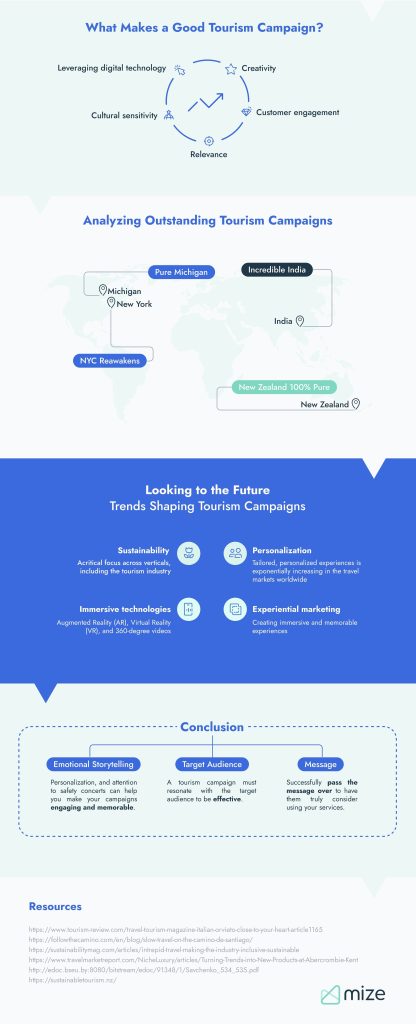4 Lessons You Can Learn From the Best Tourism Campaigns

Businesses in the tourism industry rely heavily on marketing to generate leads and boost conversion rates. Tourism marketing is as old as tourism itself – and it always reflects the destination and service benefits relevant to the current travelers’ needs, wants, and expectations.
In other words, tourism campaigns must constantly move forward, and marketers need to innovate to make them effective.
But how do you innovate, though? Let’s analyze successful tourism campaigns so we can pinpoint strategies you can adopt to step up your marketing game and achieve your goals.
What Makes a Good Tourism Campaign?
So what makes a good tourism campaign? There are many factors that can contribute to the success of these campaigns. However, the most noteworthy ones include creativity, relevance, customer engagement, cultural sensitivity, and leveraging digital technology.
Digital technology is the key element that binds all these elements together and enables tourism brands to create and launch campaigns that capture attention and foster engagement while differentiating the brand and respecting local cultures. Let’s see how these factors contribute to successful tourism campaigns.
Creativity
Creativity is a powerful tool to have at your disposal when creating marketing campaigns. It can help you make the destination attractive and capture the attention of target customers. Creativity enables compelling storytelling, visually appealing content, and unique ideas.
It reflects captivating visuals and catchy messaging, which can help generate leads among potential visitors and compel them to experience the destination firsthand.
Relevance
Relevancy is the crucial component of every content used for marketing purposes. For instance, tourism websites each feature unique content. Did you ever wonder why that is? It’s because they cater to different audiences. Every last one of travel websites and tourism campaigns leverages content relevant to the target audience.
Tailoring the messages and visuals to target the audience’s interests, desires, and needs increases the likelihood of attracting potential visitors.
Customer engagement
Successful tourism campaigns need to have at least one engaging element. These elements include user-generated content, social media campaigns, contests, etc. Their role is to invite potential visitors to participate in campaigns.
The goal is to inspire involvement, thus fostering a sense of connection. It helps increase interest, enhance the effectiveness of campaigns, and build relationships with potential visitors.
Cultural sensitivity
Cultural sensitivity becomes imperative if you genuinely want to respect every culture you want to represent in your campaigns. Diverse cultures are precisely what makes destinations attractive. Knowing how to respectfully represent them can help you avoid misrepresentations.
It builds trust with potential visitors and empowers your brand to create a positive perception of destinations and local communities.
Leveraging digital technology
Cutting-edge technologies are a lifeline of modern tourism campaigns. It enables brands to reach broad audiences, targets travelers with the intent to book and enrich their travel experiences with a wide range of perks.
Modern technology enables brands to keep channels of communication open 24/7/365 and leverage customer data to offer personalized recommendations, thus building trust and securing high conversion rates.
Let’s see the elements of a good tourism campaign in action.
Analyzing Outstanding Tourism Campaigns
Deep dive into a selection of successful tourism campaigns from the past years. Each case study will highlight the campaign’s strategy, execution, and impact, focusing on what made it successful.
New Zealand 100% Pure
The New Zealand 100% Pure tourism campaign’s strategy aimed to paint New Zealand as a country that offers adventurous experiences while making pristine landscapes and natural beauties its primary strengths. The campaign was catering to nature lovers and outdoor enthusiasts.
Execution – The team of marketers behind this campaign wanted to showcase New Zealand’s most stunning visuals, including plants and wildlife. The campaign launched in 1999, and it’s still ongoing. Initially, it leveraged mediums such as TV commercials and print advertisements. Today it’s also leveraging digital platforms and channels.
Impact – The impact of this campaign was immense. It helped significantly increase tourism in this country. More importantly, it contributed to New Zealand becoming a synonym for unique outdoor experiences.
Success factors – The main factors that contributed to this campaign’s success are precise and personalized messaging, focus on sustainability, and high-quality, stunning visuals. All these factors enabled the campaign to clearly community the strongest and most unique country’s selling points.
Incredible India
Incredible India is another excellent example of a successful tourism campaign. It’s similar to the previous one as it also aimed to community unique selling points of a country. However, this time it was more about festivals, cultural heritage, historical landmarks, and unique experiences.
Execution – Since the goal was to reach as many travelers as possible, the marketers widened their approach. Incredible Indian content was available across social media, digital platforms, print media, and TV commercials. They also used segmentation and personalized content for each segment, such as luxury travel, wellness, and adventure tourism.
Impact – The campaign positively affected inbound tourism as it brought thousands of tourists from around the world to India. Before the campaign, the country was mainly attractive to travelers interested in spiritual destinations. After the campaign, India became attractive to a wide range of travelers.
Success factors – Some major success factors here are the detailed showcasing of India’s diversity, cultural richness, and captivating storytelling. The success also followed the segmentation and content personalization strategy.
NYC Reawakens
NYC Reawakens is the most recent campaign on this list. Nevertheless, it’s as successful as previous examples. The strategy was to bring life back to the NYW after the COVID-19 pandemic. The goal was to help visitors feel confident again while highlighting the city’s safety measures, resilience, and attractive offerings.
Execution – The campaign was launched across channels. It encompassed outdoor hoarding, social media, digital ads, and TV and radio commercials. Every commercial aimed to showcase an activity or attraction only available in NYC. Marketers also decided to address traveler concerns in every ad.
Impact – NYC Reawakens is the spark that helped revitalize tourism in one of the most famous cities in the world. It made visitors confident to start traveling again, which helped recover local business and the tourism industry as a whole.
Success factors – There are a couple of critical factors that contributed to NYC Reawakens’ success. The entire campaign made sure to adequately address traveler concerns. It was perfectly timed and used powerful visuals to communicate NYC’s resilience and vibrancy.
Pure Michigan
Pure Michigan is another great example to learn from. The campaign strategy was to paint Michigan as a perfect destination to admire natural beauty, take part in outdoor activities, and be a place for families to visit.
Execution – The campaign was again a multi-channel one. The ads were spread across social media platforms, printed media, and TV commercials. Commercials featured events and attractions only available in Michigan, along with outdoor activities such as boating and hiking. The marketers decided to use breathtaking visuals.
Impact – After the campaign, tourism in Michigan increased. The campaign resonated with families and outdoor enthusiasts.
Success factors – The factors that rendered the campaign successful were stunning photos, focus on outdoor activities, and compelling storytelling. It helped Michigan become an American outdoor getaway, especially in the family segment.
Key Takeaways from Successful Campaigns
So, what lessons can you learn from these successful campaigns? Your focus should be on the strategies, as you can customize each one of the strategies used in these campaigns and use it to achieve your own marketing goals. Let’s see what you have at your disposal.
Emotional storytelling
Emotional storytelling is one of the most commonly used strategies in tourism campaigns. As you can see, it was a go-to strategy for marketers who did New Zealand and India campaigns. They used it to evoke specific emotions and have the potential visitors thinking about visiting the destination. In both cases, they leveraged it to emphasize a destination’s unique aspects and experiences.
In New Zealand campaigns, storytelling was used to evoke a sense of excitement, freedom, and awe. It also hit close to the emotions of nature lovers and those who thrive on adventures. In the Incredible India campaign, storytelling was used to evoke curiosity and joy and inspire awe and wonder.
You can adapt storytelling to your own purposes to leave a lasting impression on your target audience. Focus on unique aspects and experiences a destination has to offer and always try to evoke emotions such as awe.
Targeted audience engagement
Targeted audience engagement is also among the most commonly used strategies in travel campaigns. Masterminds behind NYC Awakens and Incredible India campaigns leveraged it to cater to the needs, wants, and expectations of every segment.
Tailoring messaging and handpicking attractions and activities that resonate with a specific segment enabled them to achieve great results. You can also use this strategy in your marketing efforts. However, to excel at it, you will need to research your target audience.
It will help you create segments by the criteria you choose, such as motivations, concerns, preferences, needs, wants, age, marital status, etc. Once you have segments, you can deliver tailored recommendations, offers, and personalized messages.
Effective use of digital platforms
Digital platforms are an essential part of modern tourism campaigns. Even the campaigns such as Incredible India and Pure Michigan, which were launched two decades ago at one point, had to expand to digital platforms. The reason is simple – digital platforms enable you to expand your reach.
Now, you should definitely use them to execute your strategies. However, you should always make sure to choose the relevant platforms. If you decide to go to social media, you should research your audience to discover the social spaces it uses. You can also use content such as quizzes and competitions to encourage content sharing and user participation.
Attention to safety measures
NYC Reawakens is a perfect example of the “attention to safety measures” strategy. It efficiently communicated safety measures to concerned travelers and encouraged them to visit NYC after the COVID-19 pandemic.
You can leverage this strategy whenever you identify concerns in your target audience. Concerns can be specific to a destination or customer segment. In either case, if you tailor your messaging right and communicate the vital safety information, you can encourage potential travelers to book.
Looking to the Future: Trends Shaping Tourism Campaigns
The entire marketing industry is evolving at a rapid pace, and it affects tourism campaigns as well. The field is quite dynamic, with many new trends shaping the future of marketing in travel. The upcoming trends encompass sustainability, immersive technologies, personalization, and experiential marketing, shaping the future of tourism campaigns.
What are these trends about, and how to incorporate them into future campaigns to stay competitive and relevant?
Let’s start with sustainability, a critical focus across verticals, including the tourism industry. People are becoming more aware of their impact on nature and want to align with brands that offer environmentally friendly and responsible experiences.
You can incorporate it easily in your campaigns. When marketing a destination, you can outline the local eco-friendly practices and conservation efforts. You can also add responsible tourism activities to your offer and promote them in your marketing mix.
Immersive technologies refer to Augmented Reality (AR), Virtual Reality (VR), and 360-degree videos. Using these technologies completely changes the tourism campaign game. They can help you differentiate your brand and reach people interested in experiencing destinations in an immersive fashion. To incorporate them, you must create AR-based apps and VR experiences. 360-degree videos are perfect for showcasing unique activities.
The demand for tailored, personalized experiences is exponentially increasing in the travel markets worldwide. Personalizing offers and recommendations is the next tourism campaign paradigm. You can implement this trend by collecting and using data about your customers.
And finally, experiential marketing is the last trend. It revolves around creating immersive and memorable experiences. It goes beyond sending your marketing message across. Experiential marketing campaigns in the travel sector aim to evoke emotions and enable potential travelers to interact with your brand. You should consider organizing events for travelers and leveraging user-generated content in your social media campaigns.
Conclusion
It’s clear that a tourism campaign must resonate with the target audience to be effective. Marketers have several ways to achieve that: technology, creativity, relevance, engaging visuals and messaging, and being culturally sensitive.
The strategies such as emotional storytelling, personalization, and attention to safety concerts can help you make your campaigns relevant, engaging, and memorable. However, to stay truly relevant, you have to keep up with the trends in the niche, such as sustainability, immersive technologies, and experiential marketing.
Implementing these insights and lessons in your tourism marketing strategies can help you stand out from the crowd, reach the right people at the right time, and successfully pass the message over to have them truly consider using your services or buying travel products from you.
FAQs
Cultural sensitivity is crucial in tourism campaigns. Learning how to represent cultures respectfully in your campaigns is essential in avoiding misrepresentations.
Storytelling plays a unique role in creating effective tourism campaigns. It can help you evoke feelings such as awe, excitement, and freedom and leave a lasting impression on your target audience.
Your go-to example of addressing travelers’ safety concerns in tourism campaigns should be NYC Awakens. You can leverage messaging to communicate safety measures and make visitors feel confident to visit a location.
People in the local audience can serve as ambassadors of the destination. You can engage them by involving local influencers, encouraging user-generated content, organizing local events, collaborating with local businesses, and featuring local success stories in your campaigns.
Subscribe to
our newsletter
Yay! You are now
subscribed to our
newsletter
Mize is the leading hotel booking optimization solution in the world. With over 170 partners using our fintech products, Mize creates new extra profit for the hotel booking industry using its fully automated proprietary technology and has generated hundreds of millions of dollars in revenue across its suite of products for its partners. Mize was founded in 2016 with its headquarters in Tel Aviv and offices worldwide.
Related Posts

Travel Niche: What It Is, How to Leverage It, Case Studies & More
14 min. Niche travel is one of the few travel sectors that have maintained their pre-COVID market growth. By catering to specific traveler segments, niche travel developed products around adventure travel, eco-tourism, LGBTQ+ travel, and wellness retreats. Take adventure tourism as only one segment of the niche tourism market. In 2021, it reached 288 billion […]

The Vital Role of Market Segmentation in the Tourism Industry
15 min. The tourism industry is an ever-growing and competitive landscape, presenting both challenges and opportunities for businesses operating within it. This is where market segmentation comes in handy. In this blog post, we will discuss what market segmentation is, the importance of market segmentation in the tourism industry, and how online travel agencies can […]
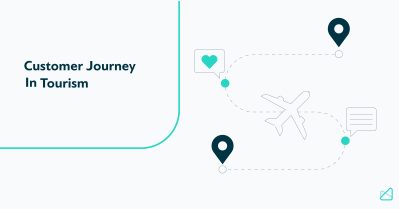
This is the Way to Create Memorable Customer Journeys in Travel and Tourism
21 min. The travel and tourism industry is an increasingly competitive space, with customers expecting more personalized and memorable experiences from their trips. With the rise of technology and social media, travelers have greater access to information and a wider range of options than ever before. Journey mapping offers travel agencies a way to gain […]
